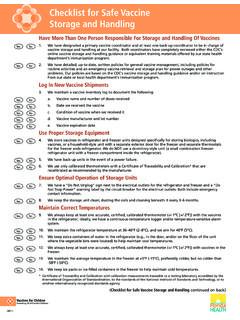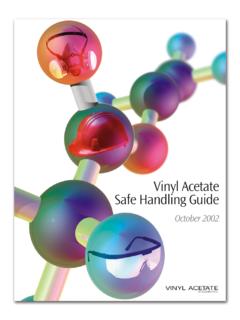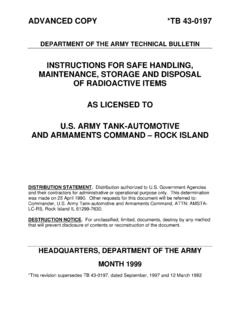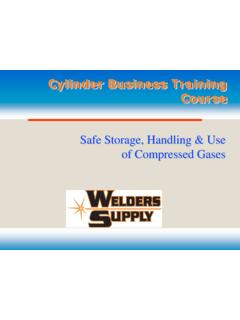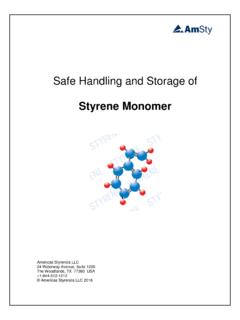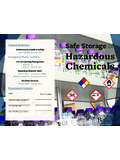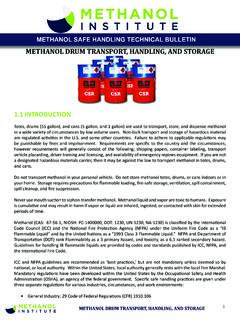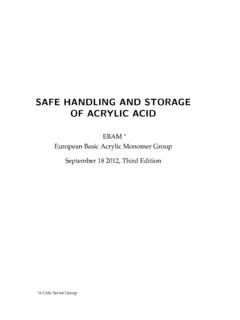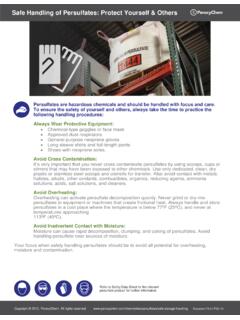Transcription of Safe Handling and Storage of Fuel and Dangerous Goods
1 Airside Operational Instruction TBA. safe Handling and Storage of fuel and Dangerous Goods safe Handling and Storage of fuel and Dangerous Goods Airside Operational Instruction 20. Content 1. Aviation fuel Management 2. Parking Arrangements-Flights Carrying Explosives 3. Carriage of Electric Mobility Aids 20130401 East Midlands Airport Aerodrome Manual 2013 v1. Uncontrolled when printed AOI Issue Date: 01 April 2013 Page 0 of 10. Airside Operational Instruction 20 safe Handling and Storage of fuel and Dangerous Goods SECTION 1 AVIATION fuel MANAGEMENT. 1 Safety Measures Requirements The EASA IR, requires that the aerodrome operator shall verify that organisations involved in storing and dispensing of fuel to aircraft have procedures to ensure that aircraft are provided with uncontaminated fuel and of the correct specifications.
2 East Midlands Airport adopts CAP 748 Aircraft Fuelling and fuel Installation Management . in conjunction with Explosive Atmospheres (ATEX) and Dangerous Substances Explosive Atmosphere (DSEAR) Regulations as best safety practice. Operators are to ensure they comply with the requirements of these regulations and that their staff are aware of their provisions. Fuelling Zones a. A fuelling zone is defined under the Dangerous Substances and Explosive Atmosphere Regulations' (DSEAR) as an area that would qualify as either;. Zone 0 A place in which a potentially explosive atmosphere consisting of a mixture with air of Dangerous substances in the form of gas, vapour or mist will occur continuously, for long periods or very frequently.
3 Anywhere where a potentially explosive atmosphere might be expected for more than 1000 hours a year. Zone 1 A place in which a potentially explosive atmosphere consisting of a mixture with air of Dangerous substances in the form of gas, vapour or mist will occur occasionally in normal operation. The hazard would not be expected to occur for more than 1000 hours a year. Zone 2 A place in which a potentially explosive atmosphere will occur rarely, abnormally and will not persist for long. The hazard would not be expected to occur for more than 10 hours a year. EMA adopts the larger of the industry standards for these zones (in a temperate climate), which is 3 metres.
4 Therefore, when aircraft fuelling operations are in progress a fuelling zone is established of at least 3 metres radially from the aircraft filling and venting points, and from any part of the fuelling vehicle and its equipment including hoses. b. Non-intrinsically safe equipment including portable electronic devices (PEDs), such as mobile telephones (including use of apps / torch function), pagers, radios and any other electronic or electrically operated equipment are prohibited from any part of the refuelling zone. Particular aspects regarding fuelling zones which airside operators/personnel need to be aware of include: i. The use of any equipment with the potential to create or induce a source of ignition should be identified and excluded from any Fuelling Zone.
5 Equipment maintenance, repairs, and testing procedures, including the operation of switches or other devices, Uncontrolled when printed Page 1 of 9. 2018, Airside Operational Instruction 20 safe Handling and Storage of fuel and Dangerous Goods with the potential to create a source of ignition within the Fuelling Zone should be deferred until fuelling has finished. ii. During fuelling operations, air and fuel vapour are displaced from the aircraft fuel tanks. This potentially explosive vapour is expelled via vent points (these tend to be located near the aircraft wingtips on both sides of the aircraft). iii. Ground Power Units (GPU's) may be operated outside the fuelling zone, however the connection and disconnection of GPU'S, where the connection point is within the fuelling zone, is prohibited.
6 On smaller aircraft Jetstream 41, the GPU connection point may be within the fuelling zone. Operators are to liaise with the fuelling supervisor to ensure that GPU connection or disconnection is not carried out during the fuelling operation. iv. Operators must ensure that passengers do not enter the fuelling zone whilst embarking or disembarking. v. Operators must be aware that where aircraft are being refuelled on adjacent stands the fuelling zone may extend between both aircraft in its entirety. Refuelling with Passengers on board an Aircraft a. Provision should be made for the safe evacuation of passengers and/ or ground staff in the event of an emergency, via at least two of the main passenger doors (or the main passenger door plus one emergency exit when only one main door is available), and preferably at opposing ends of the aircraft.
7 Throughout the fuelling operation these doors, or emergency exits, should be constantly manned by a cabin attendant. b. If an emergency exit with an inflatable slide is designated to meet the above requirements, the deployment area must be kept clear of external obstruction and the fuelling supervisor must be informed. The access and egress routes from areas where slides might be deployed must also be kept clear. c. The Operations Control Room, ext. 2973, is to be informed if it is intended to conduct aircraft fuelling operations with passengers on board. Although not required, EMA. RFFS will attend if requested to do so. Requests for this service should be made through The Operations Control Room.
8 D. Ground staff carrying out their duties on board an aircraft are also bound by the provisions as detailed above. e. If for any reason an operator is not able to comply fully with the requirements they must apply for written consent from the Head of Fire and Airfield Operations to refuel aircraft with passengers on board. f. Consent to refuel aircraft with passengers on board will only be given once satisfactory risk assessments and safe systems of work have been submitted to the Head of Fire and Airfield Operations by the operator. fuel Spillages (Action by Fuellers). a. The following procedures are to be incorporated into existing company procedures, by aircraft fuellers, in the event of a fuel spillage whilst carrying out aircraft fuelling operations: Uncontrolled when printed Page 2 of 9.
9 2018, Airside Operational Instruction 20 safe Handling and Storage of fuel and Dangerous Goods i. STOP FUELLING release dead man control, activate emergency cut off device. ii. The Fuelling Overseer should notify the aircraft operator and EMA Operations Control Room if the spillage is likely to create a fire hazard, if the spillage covers an area in excess of 2 sq. metres, or if the spillage enters the drainage system. iii. Alert personnel and airline staff within the vicinity and where possible, prevent ingress into the affected area by other vehicles and/or personnel. iv. Keep all spark producing equipment and sources of ignition away from the area until the fuel is completely vaporised and the fuel vapour has dissipated.
10 V. If safe to do so, and the spillage is not within 6 metres of the engine compartment, disconnect all fuelling nozzles and bonding leads from the aircraft, reel in the fuelling hoses and move the fuelling equipment away from the spillage, to a safe area. vi. Do not start engines or move the fuelling vehicle if the fuel spillage is within 6 metres of the vehicle engine compartment, unless instructed to do so by the attending Fire Officer. vii. Ensure that all minor spillages are cleared up using the appropriate absorbent materials which should then be removed and disposed of safely. b. The following procedures are to be incorporated into existing company procedures by aircraft fuellers, in the event of a fire during aircraft fuelling operations: i.
